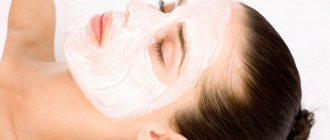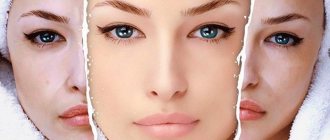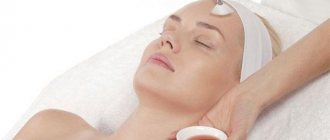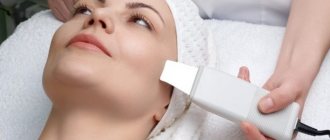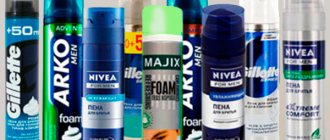Beautiful and healthy skin is the desire of every person, but such a gift is not given by nature to everyone. You can “get” and maintain healthy skin through skillfully directed efforts, including those of professional cosmetologists and estheticians. Especially when it comes to problematic skin of patients with acne, a disease that leads to irreversible cosmetic defects and psychosocial maladjustment of the patient.
Hygienic facial cleansing is not a strict template, but a wide field for creativity of a cosmetologist
Facial cleansing is a common and widely used procedure that provides a high and fairly rapid effect of complex treatment for patients with acne, and allows one to activate internal repair processes. And regular implementation of this procedure promotes deep cleansing, regeneration and enhances the results of subsequent procedures carried out in a beauty salon.
Hygienic cleansing of facial skin is a specific and at the same time vague concept; it is not a strict template, but a wide field for the cosmetologist’s creativity, allowing him to select a procedure based on the needs of the client’s skin and lay a good foundation for subsequent cosmetic programs.
Until recently, no one doubted the effectiveness of this procedure. However, now many experts question the advisability of deep cleaning. Of course, everyone decides for themselves whether to use it in their practice. But in order to form our own opinion and make the right choice, let’s look at this problem in more depth. First, let's remember the structure of the skin and sebaceous glands (Fig. 1) and their functions.
Rice. 1. Structure of the sebaceous gland
Composition of the sebaceous gland secretion:
- triglycerides of fatty acids and their hydrolysis products - 50-55%;
- wax esters - 25%;
- squalene -10%:
- free cholesterol - 1%;
- other sterols - 1%;
- other substances - 1%.
The main functions of the sebaceous gland and its secretion:
- prevents water evaporation;
- participates in maintaining a constant temperature;
- neutralizes alkalis and acids on the skin surface;
- has antimicrobial, fungicidal, virusostatic, antioxidant effects;
- carries out excretion of metabolic products, medicinal and toxic substances;
- softens hair, gives it water-repellent properties;
- reduces the penetration of UV rays into the skin.
The secretory section of the sebaceous gland consists of 12-18 secretory lobules surrounded by connective tissue. Each lobule, in turn, consists of acini - subunits of the secretory department, and the acinus - of basal cells and sebocytes, the average lifespan of which is 2-3 weeks. As they move towards the lumen of the duct, sebocytes are destroyed. The destroyed cells, together with the secretion of the sebaceous glands, enter the excretory duct of the sebaceous gland.
The secretion of the sebaceous glands is a product of physiological degeneration of sebaceous gland cells. In addition to hypersecretion of the secretion of the sebaceous glands and biochemical changes in its composition, there are other factors leading to the formation of comedones. Epithelial cells - the funnels of the sebaceous gland duct - become keratinized slowly and come to the surface of the skin along with the secretion of the sebaceous glands. In the process of hyperkeratinization of the follicular canal, the normal exfoliation of epithelial cells is disrupted, which leads to blockage of the sebaceous gland with horny masses and the formation of comedones. If the horny masses accumulate at the exit hole, an open comedon . When the excretory duct is blocked in the center, the outlet does not expand, all waste products of the sebaceous glands accumulate and form into closed comedones .
Vacuum cleaning
The procedure is based on the dosed action of negative atmospheric pressure (air is pumped out from the drainage tube of the device).
Several types of nozzles are used:
- Beak-shaped - for treating the T-zone.
- Flat - for working with wrinkles.
- A round drainage tube provides lymphatic drainage.
The technique is atraumatic - this is its main advantage. It is suitable for caring for oily, combination and normal skin.
Vacuum cleaning is often carried out after casting.
Indications:
- aging skin with reduced turgor;
- acne, comedones.
Efficiency
The effect of vacuum helps improve blood flow and lymph outflow in the treated area, as a result, natural regeneration processes are activated and swelling is reduced.
The device sucks out comedones and also has a slight exfoliation effect. After the first procedure, some of the blackheads disappear, the skin becomes cleaner and fresher.
Carrying out the procedure
The patient is placed on the couch and his hair is tucked under a cap.
Treatment is carried out in strict sequence along massage lines:
- Chin: movement from bottom to top towards the nose or up and to the side towards the cheeks.
- Cheeks: movements seem to tighten the skin - from the nose to the ears.
- The forehead is processed in different directions.
- A round nozzle of small diameter is used for the nose, the back is worked with longitudinal movements, and the wings are worked with circular movements.
Stages:
- Thorough make-up removal, cleansing and degreasing of the skin.
- Carrying out disincrustation.
- Carrying out cleansing therapy using a vacuum apparatus. Depending on the area being worked on, the appropriate nozzle is selected (beak-shaped, flat or round).
- Apply a soothing, regenerating and pore-tightening mask and cream.
The session takes 40-50 minutes. It is permissible to repeat 3-4 times per year with an interval of 3-4 months.
Precautionary measures
The vacuum cleaning procedure is considered gentle, but does not completely guarantee the preservation of tissue integrity.
It is important to remember to disinfect and sterilize attachments. You should also not lose sight of contraindications, neglect of which can harm not only beauty, but also your health.
Side effects:
- The introduction of pyogenic flora into the tissue with the subsequent development of pustular diseases of the dermis.
- Persistent hyperemia (more than 48 hours).
- Formation of edema, pinpoint hemorrhages, hematomas (in case of poor technique, weak capillaries).
Contraindications:
- Dry skin.
- Expanded subcutaneous capillary network.
- Telangiectasia.
- Rosacea.
- Any infections in the active phase.
- Chronic dermatoses during exacerbation.
Buyanov Sergey Yurievich (Expert Doctor):
Vacuum use is contraindicated during pregnancy. The procedure causes a state of local stress, which can spread to the entire body, including the uterus and fetus.
Which method is better
It’s difficult to say for sure what to choose. Each procedure has its own specific features, positive and negative sides, indications and contraindications.
So, if a person experiences an exacerbation of rashes, then a mechanical type of cleansing is best suited. Other options are contraindicated for use in this condition.
In cases where there are no visible defects, but there are uneven skin surfaces, experts recommend laser cleansing.
On this topic
- Face cleaning
All about when you can do facial cleansing
- Inna Viktorovna Zhikhoreva
- June 19, 2020
For oily skin types, as well as for blackheads, any method except the two described above is suitable.
You can try each type of cleansing, based on the price range, personal preferences and individual characteristics of the body.
Manual cleaning
The procedure is one of the most “ancient” and reliable, it is of the mechanical type. It helps eliminate blackheads, cleanses pores of impurities, and also removes blackheads and milia.
After the recovery period, the face looks noticeably healthier and well-groomed.
Buyanov Sergey Yurievich (Expert Doctor):
The advantage of the classical procedure is complete control over the actions and condition of the patient, which is impossible to achieve with “machine cleaning”.
Indications:
- Oily, problem or combination skin.
- Presence of acne, comedones, milia.
- Enlarged pores and blackheads.
Carrying out the procedure
The patient is placed on the couch, his hair is tucked under a disposable cap.
The doctor washes his hands with soap, puts on gloves and gets to work: he presses on the pore with two index fingers, and removes the freed acne with a napkin.
The session takes 45-50 minutes, procedures are carried out more often than once every 2-3 months.
Precautionary measures
Failure to comply with the technology can lead to blood poisoning (violation of asepsis, squeezing out festering elements).
Side effects:
- Development of pustular diseases.
- Formation of scars after rough work by a master.
- Petechiae.
- Long-lasting hyperemia or swelling.
Contraindications:
- Inflamed, suppurating acne.
- Pustular diseases (sycosis, furunculosis, carbunculosis).
- Blood clotting disorder.
- Dry, sensitive skin.
Brushing
Brushing, or brossage, is used for the purpose of superficial exfoliation and polishing.
Fine bristles effectively remove dirt and horn cells.
Massage stimulates blood circulation, thereby improving trophism and cellular metabolism. The complexion improves, the skin becomes smoother and healthier.
Indications:
- The presence of blackheads, enlarged pores and comedones.
- Problem skin.
- Uneven complexion, unhealthy color.
- Adolescence.
- Loss of elasticity.
Procedure protocol
For brushing, a special apparatus is used, which is equipped with a handle with a removable brush attachment. At home, you can use a manual brush or a portable electronic device.
The doctor first selects the stiffness of the brush, the speed and direction of movement of the nozzle.
Stages:
- First, the skin is cleansed and degreased.
- Afterwards the scrub is applied, distributed along the massage lines and removed using damp sponges.
- Apply nourishing or moisturizing cream under the polishing attachment and massage for 3-5 minutes.
Direction of movement:
- Chin: in the shape of an inverted letter U, but you can apply a little more pressure than in other areas.
- Cheeks: upward and outward circular movements, returning to the starting point.
- Nose: small circular movements at the tip of the nose and at the wings, then along the back to the space between the eyebrows.
- Forehead: in circular motions from the center to the periphery.
Brushing is a gentle method of cleansing, so it is carried out 1-2 times a month.
Precautionary measures
Failure to comply with the technique can lead to stretching of the tissue, loss of tone and elasticity, and unscrupulous processing of the working tool is fraught with the development of complications.
Side effects:
- Pustular lesion of the dermis.
- The appearance of excessive dryness, irritation.
- Persistent hyperemia.
Contraindications:
- The presence of an active inflammatory process.
- Sensitive, irritated skin.
- Vascular mesh.
- Violation of tissue integrity.
- Large nevi, papillomas.
Contraindications
Despite the fact that salon techniques are common and in demand, they are not suitable for all people.
On this topic
- Face cleaning
How often should you cleanse your face?
- Olga Aleksandrovna Kalinina
- October 18, 2020
Thus, among the most common contraindications, cosmetologists identify:
- diabetes ; _
- pathologies of the heart and blood vessels;
- dermatological problems ;
- upper respiratory tract diseases.
It is prohibited to carry out such a professional procedure during pregnancy and breastfeeding.
You should make a decision about using one or another method of cleansing your facial skin only after receiving advice from a specialist. Independent choice can lead to serious complications.
Ultrasonic cleaning
The operation of the device is based on the oscillation of ultrasonic waves emanating from the handpiece. The generated waves cause alternating acoustic pressure on the liquid medium applied to the skin and form “microjets”, which in turn have a peeling effect.
In addition, ultrasound vibrations perform micromassage, promote hydration of the dermis, activate cellular metabolism, tissue regeneration, as well as the synthesis of collagen and elastin.
The effectiveness of the procedure: superficial cleansing of pores, evening out tone and imparting radiance due to a pronounced exfoliating effect, stimulation of blood circulation and improvement of complexion, normalization of the sebaceous glands and reduction of sebum secretion in the aftermath.
Procedure protocol
Stages:
- Thorough makeup removal and cleansing with specialized products, degreasing the skin.
- Applying a warming mask under the film for 10-15 minutes helps to expand the pores.
- Zonal film removal followed by wet-on-wet cleaning (special tonics or lotions are used).
- Toning, restoring pH, after ultrasonic exposure.
- Applying a mask to close the pores.
- Apply moisturizer, in summer - with SPF.
Precautionary measures
Acne, severe inflammation, dry, irritated and sensitive skin are the main contraindications to manipulation.
Effect
Each type of professional facial cleansing by a cosmetologist is aimed at solving a specific problem.
The procedure carried out in the salon contributes to:
- acne marks and pimples;
- improving the appearance of facial skin;
- relieving severe fatigue ;
- reducing the likelihood of new defects ;
- saturation of cells with oxygen ;
- pulling up;
- increasing elasticity and firmness.
For the most effective results, several sessions may be required. It is important to take into account the initial condition of the skin and the capabilities of a particular method.
Laser facial cleansing
Laser facial cleansing (dermal peeling) is the use of high-intensity laser radiation to even out uneven skin texture and color.
Absorption of radiation by the surface layers of the epidermis causes them to evaporate, while deeper cells are not affected.
Procedure protocol
First, he prepares the patient: the hair is tucked under a disposable cap, protective goggles are put on the eyes, and the entire treated area is disinfected.
The doctor works with the laser at a distance of 3-15 cm, depending on the device. The beam sequentially passes through all zones on the face, without entering the same field twice.
Areas that have already been laser treated become lighter.
When the entire face has been treated, the dermis is re-treated with antiseptic solutions.
Recommendations for the number of sessions:
- Superficial peeling: 3-4 procedures with an interval of 2-3 weeks. No more than 2-3 courses per year.
- Medium: 3-4 procedures with an interval of 4-5 weeks. No more than 2 courses per year.
- Deep: 1-2 manipulations at long intervals (up to 3-4 months). No more than 1 course per 5-7 years.
Features of the recovery period
With medium and deep laser cleaning, rehabilitation lasts 2-4 weeks. Patients are under strict supervision and control of doctors, following all recommendations individually.
In the first days, the area affected by the laser is sharply hyperemic and swollen. Then a brown scab-crust forms, which is strictly forbidden to be forcibly removed because it serves as a protective barrier from the external environment.
Precautionary measures
2 weeks before the procedure it is prohibited:
- sunbathing and visiting a solarium;
- take any antibacterial drugs;
- conduct chemical peels in salons.
In 3 days exclude:
- application of alcohol-containing products;
- swimming pool and sauna.
What's happened
Facial cleansing in a salon is a procedure during which not only various impurities, but also dead cells are removed from the surface of the skin. As a result of the accumulation of these elements, the skin ceases to receive all important substances in the required quantities along with creams, lotions and masks.
This procedure is needed to unclog clogged pores and can be used in cosmetology regardless of skin type.
During its implementation, specialists pay increased attention to inflamed areas. In addition, the procedure helps restore blood circulation and activate metabolic processes that occur in the layers of the epidermis.
Rehabilitation period
There are general rules that must be followed after any type of cleaning.
- It is forbidden to wash your face for 24 hours
- In the first 3-5 days, use cream with SPF (at least 30)
- Do not use aggressive cosmetics or perform chemical peeling.
- Avoid harsh mechanical impact on the treated area.
- Do not apply makeup until complete healing.
- Use moisturizing serums or creams daily.
- Take any antibacterial drugs.
- Do not visit the sauna, bathhouse, swimming pool or solarium.
- If necessary, apply anti-inflammatory agents to irritated areas.
Proper preparation
Regardless of which facial cleansing technique will be used, in order for the final result to be as effective as possible, it is necessary to properly prepare for the session.
First of all, the specialist examines the skin, determines its type and, taking these factors into account, offers the optimal type of procedure. If necessary, he can direct the patient to undergo certain tests and undergo instrumental examination to identify certain diseases for which such manipulations cannot be performed.
If there are no restrictions, then you will need to give up tanning both in a solarium and in direct sunlight, drink alcoholic beverages, and also stop using certain cosmetics within a few days.
The skin of the face also requires appropriate preparation.
On this topic
- Face cleaning
Facial cleansing for men
- Olga Aleksandrovna Kalinina
- August 30, 2020
For this purpose, the cosmetologist must first of all thoroughly disinfect all the instruments that will be used in the process. To do this, take an antiseptic solution.
It is important to thoroughly cleanse the skin and remove residual makeup, sebum and impurities.
The stratum corneum, which requires preliminary softening, is not left without attention.
